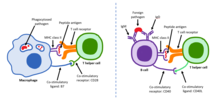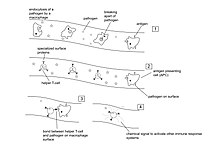Immune response
An immune response is a physiological reaction which occurs within an organism in the context of inflammation for the purpose of defending against exogenous factors. These include a wide variety of different toxins, viruses, intra- and extracellular bacteria, protozoa, helminths, and fungi which could cause serious problems to the health of the host organism if not cleared from the body.[1]
In addition, there are other forms of immune response. For example, harmless exogenous factors (such as pollen and food components) can trigger allergy; latex and metals are also known allergens. A transplanted tissue (for example, blood) or organ can cause graft-versus-host disease. A type of immune reactivity known as Rh disease can be observed in pregnant women. These special forms of immune response are classified as hypersensitivity. Another special form of immune response is antitumor immunity.
In general, there are two branches of the immune response, the
The innate branch—the body's first reaction to an invader—is known to be a non-specific and quick response to any sort of pathogen. Components of the innate immune response include physical barriers like the skin and mucous membranes, immune cells such as neutrophils, macrophages, and monocytes, and soluble factors including cytokines and complement.[2] On the other hand, the adaptive branch is the body's immune response which is catered against specific antigens and thus, it takes longer to activate the components involved. The adaptive branch include cells such as dendritic cells, T cell, and B cells as well as antibodies—also known as immunoglobulins—which directly interact with antigen and are a very important component for a strong response against an invader.[1]
The first contact that an organism has with a particular antigen will result in the production of effector T and B cells which are activated cells that defend against the pathogen. The production of these effector cells as a result of the first-time exposure is called a primary immune response. Memory T and memory B cells are also produced in the case that the same pathogen enters the organism again. If the organism does happen to become re-exposed to the same pathogen, a secondary immune response will kick in and the immune system will be able to respond in both a fast and strong manner because of the memory cells from the first exposure.[3] Vaccines introduce a weakened, killed, or fragmented microorganism in order to evoke a primary immune response. This is so that in the case that an exposure to the real pathogen occurs, the body can rely on the secondary immune response to quickly defend against it.[4]
Innate part
The
Pathogens are recognized and detected via pattern recognition receptors (PRR). These receptors are structures on the surface of macrophages which are capable of binding foreign invaders and thus initiating cell signaling within the immune cell. Specifically, the PRRs identify pathogen-associated molecular patterns (PAMPs) which are integral structural components of pathogens. Examples of PAMPs include the peptidoglycan cell wall or lipopolysaccharides (LPS), both of which are essential components of bacteria and are therefore evolutionarily conserved across many different bacterial species.[6]
When a foreign pathogen bypasses the physical barriers and enters an organism, the PRRs on macrophages will recognize and bind to specific PAMPs. This binding results in the activation of a
Adaptive part

The
Specificity in the adaptive branch is due to the fact that every B and T cell is different. Thus there is a diverse community of cells ready to recognize and attack a full range of invaders.[8] The trade-off, however, is that the adaptive immune response is much slower than the body's innate response because its cells are extremely specific and activation is required before it is able to actually act. In addition to specificity, the adaptive immune response is also known for immunological memory. After encountering an antigen, the immune system produces memory T and B cells which allow for a speedier, more robust immune response in the case that the organism ever encounters the same antigen again.[8]
Types of immune response

Depending on exogenous demands, several types of immune response (IR) are distinguished. In this paradigm, immune system (both innate and adaptive) and non-immune system cellular and molecular components are organized to optimally respond to distinct exposome challenges.
Currently, several types of IR are classified.[10][11]
Type 1 IR is elicited by viruses, intracellular bacteria, parasites. The actors here are group 1 innate lymphoid cells (ILC1), NK cells, Th1 cells, macrophages, opsonizing IgG isotypes.
Type 2 IR is caused by toxins and multicellular parasites. ILC2, epithelial cells, Th2 lymphocytes, eosinophils, basophils, mast cells, IgE are key players here.
Type 3 IR targets extracellular bacteria and fungi by recruiting ILC3, Th17, neutrophils, opsonizing IgG isotypes.
Additional types of IR can be observed in noninfectious pathologies.[12]
All types of IR have sensor (ILCs, NK cells), adaptive (T and B cells), and effector (neutrophils, eosinophils, basophils, mast cells) parts.[11]
References
- ^ ]
- ^ OCLC 1023865227.]
{{cite book}}: CS1 maint: location missing publisher (link) CS1 maint: others (link)[page needed - ^ "Immune system – Evolution of the immune system". Encyclopedia Britannica. Retrieved 2020-03-09.
- ^ "vaccine | Definition, Types, History, & Facts". Encyclopedia Britannica. Retrieved 2020-03-09.
- ^ ]
- ^ "The Innate Immune System: Early Induced Innate Immunity: PAMPs". faculty.ccbcmd.edu. Archived from the original on 2020-02-01. Retrieved 2020-03-08.
- PMID 20838815.
- ^ PMID 20061006.
- ISBN 0815341016.
- PMID 25528359.
- ^ ISBN 978-0815345848.
- PMID 29114938.
